Abstract
Heart rate, blood pressure, pulsus paradoxus, and cardiac output measured by means of transthoracic electrical impedance cardiography have been recorded in 29 children mean age 10 years +/- 2 SD during status asthmaticus. Changes were recorded over the first two hours of treatment during which all patients received oxygen, intravenous fluid, and hydrocortisone, and were randomly assigned to receive aminophylline, salbutamol, or both. Admission values showed significant correlation of pulsus paradoxus with PaCO2 (r = 0.66). Pulsus paradoxus was greater than 20 mmHg for all patients with PaCO2 above 5.5 kPa. Mean stroke volume and cardiac output were 89% and 131% of the resting convalescent values in the same children. Stroke volume cardiac output and heart rate did not correlate with peak expiratory flow rate or blood gas measurements. Aminophylline and salbutamol together were associated with significantly greater increase in PEF than aminophylline alone (P less than 0.05). Nebulised salbutamol was just as effective as intravenous salbutamol. Heart rate and systolic blood pressure declined significantly after nebulised salbutamol and aminophylline, but not after intravenous salbutamol and aminophylline. Stroke volume and cardiac output did not change significantly in any treatment group.
Full text
PDF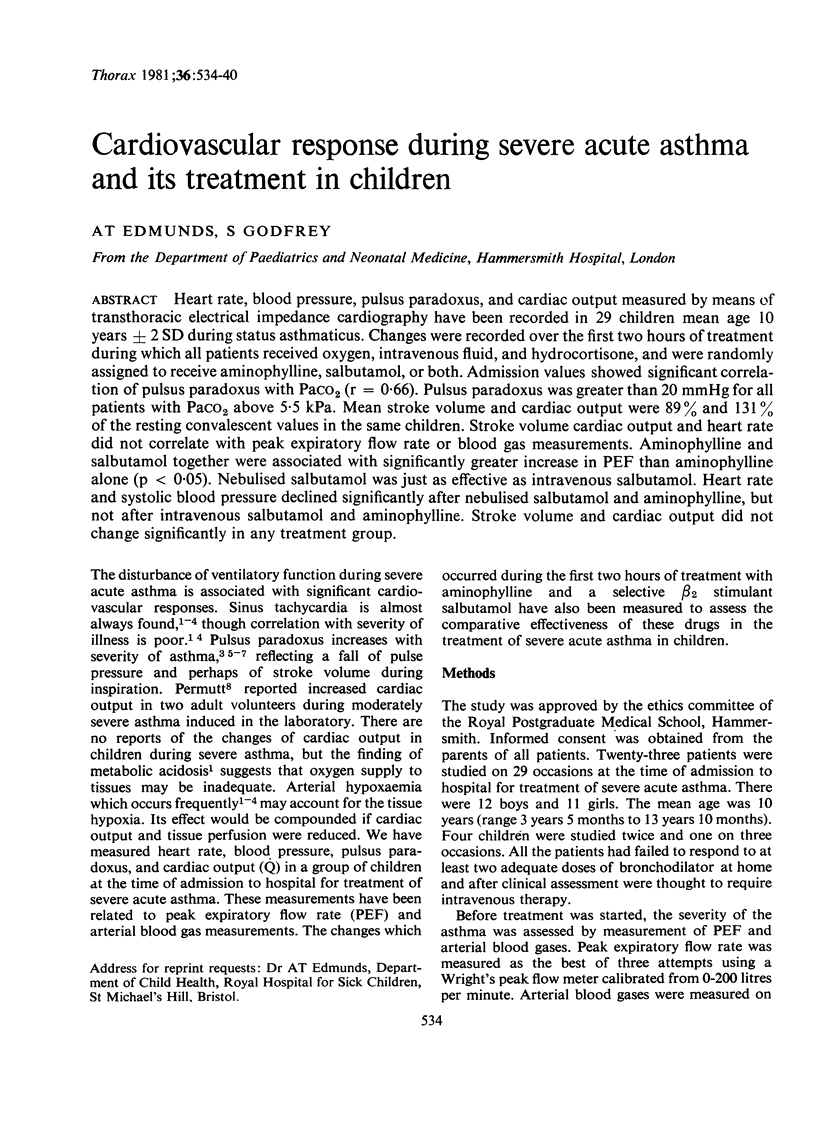
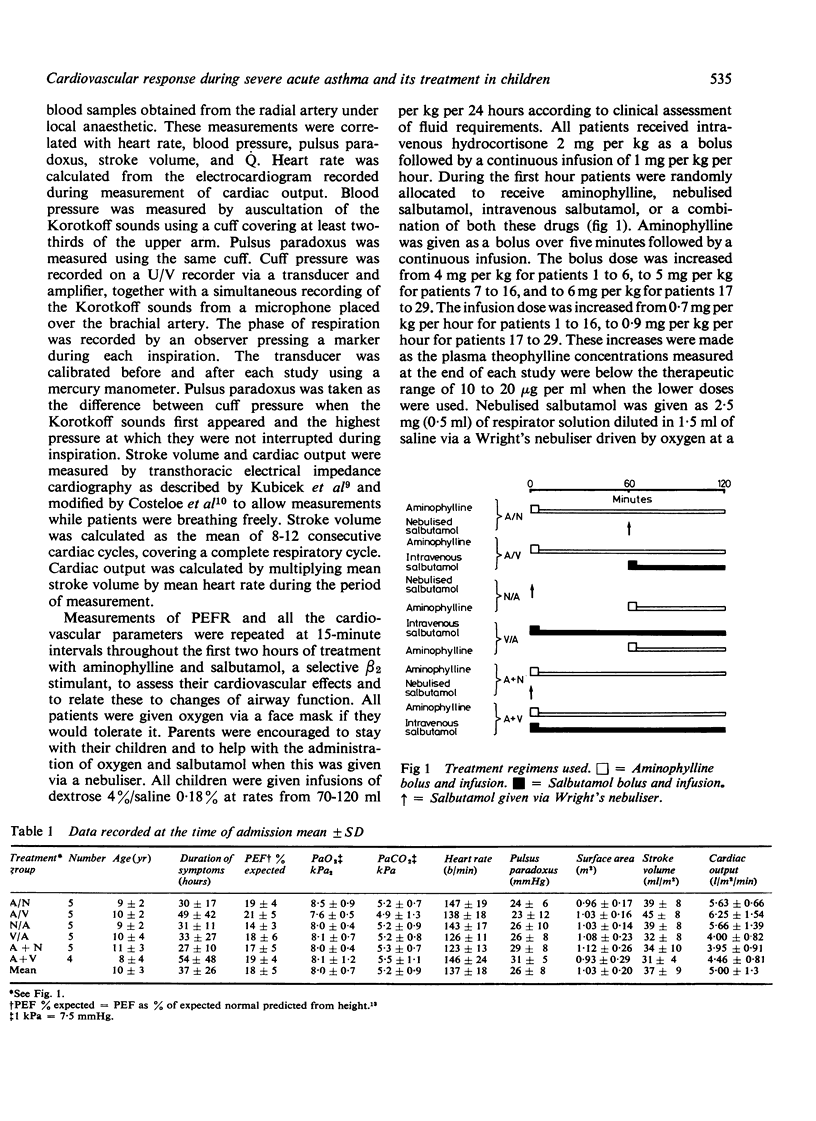
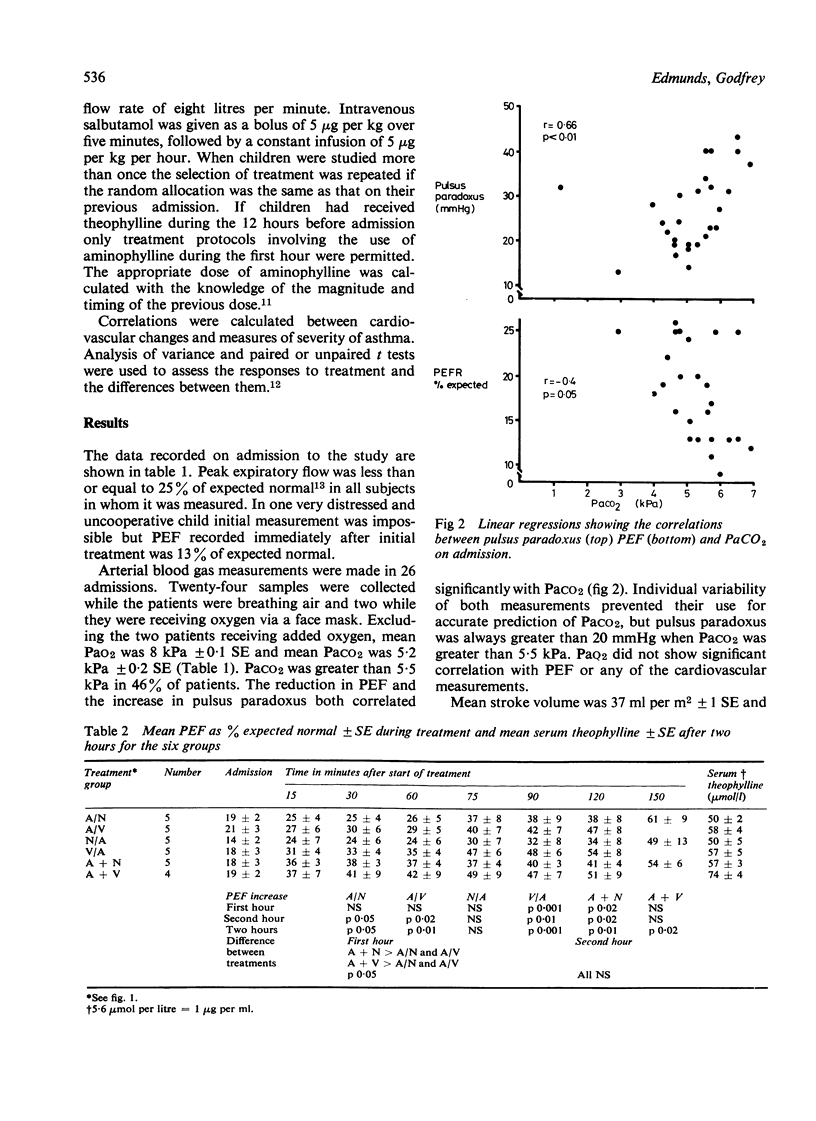
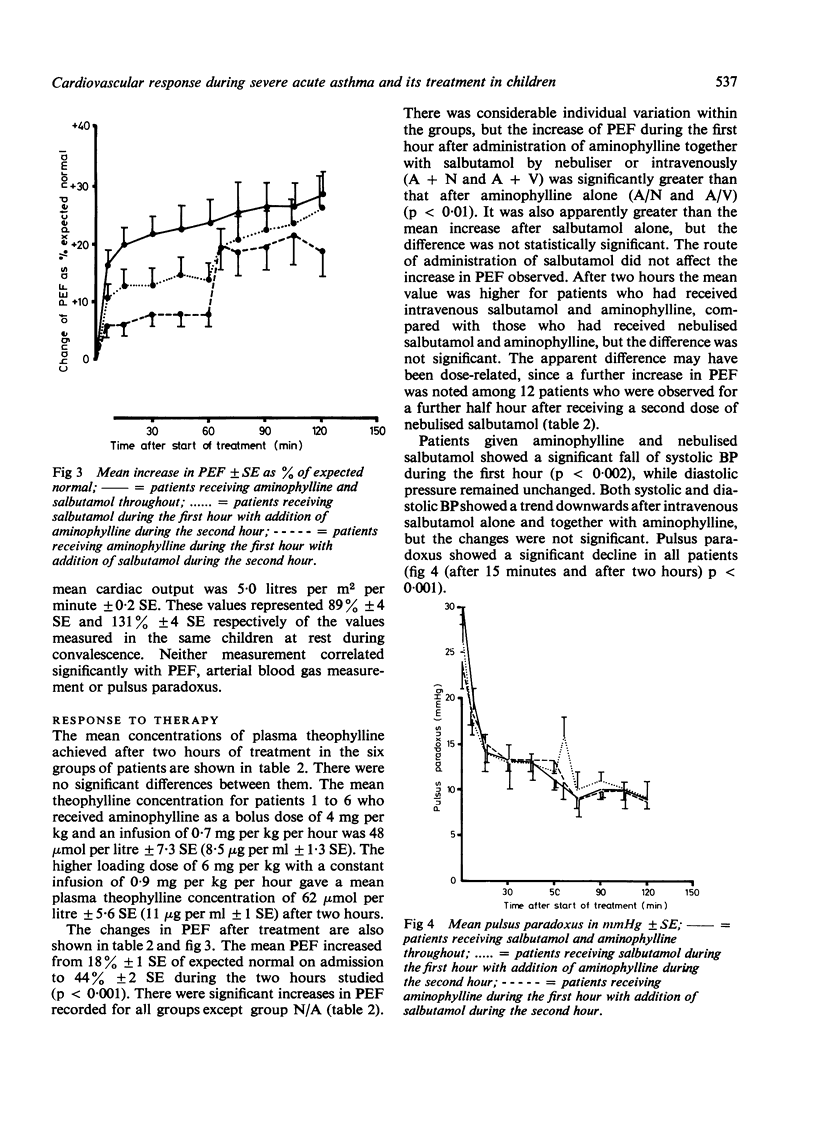
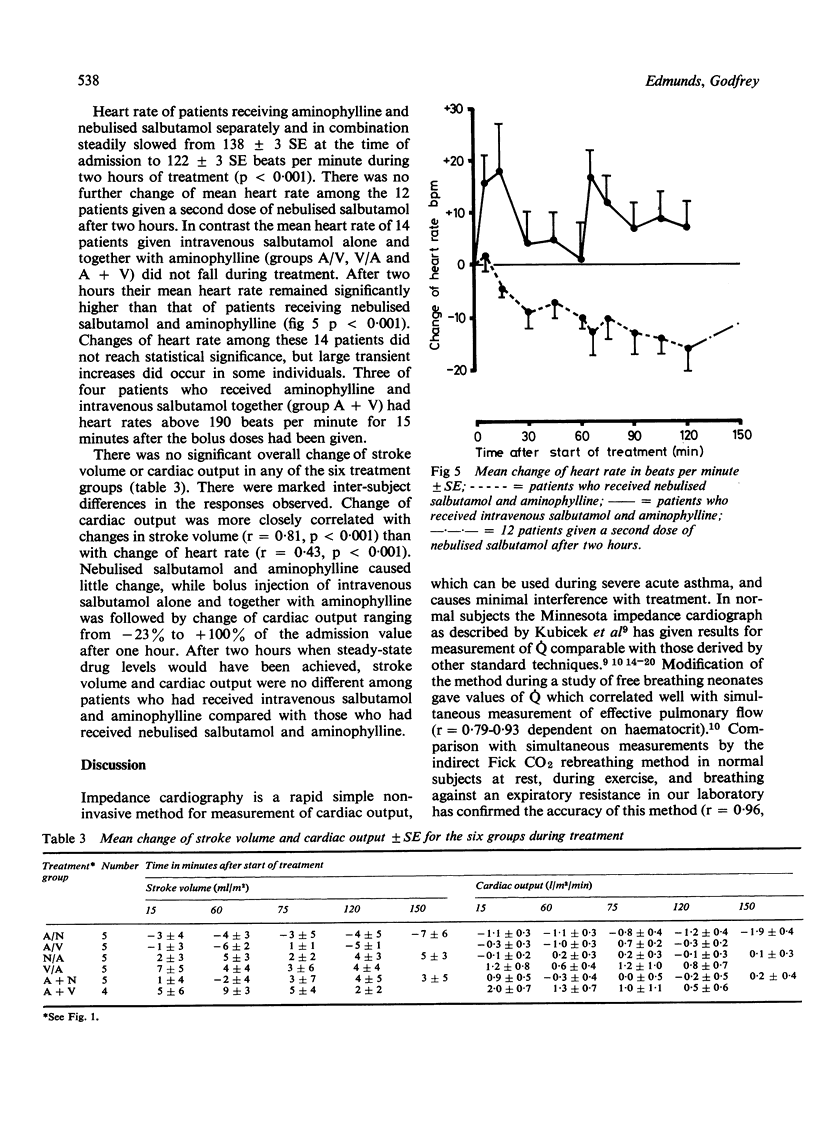
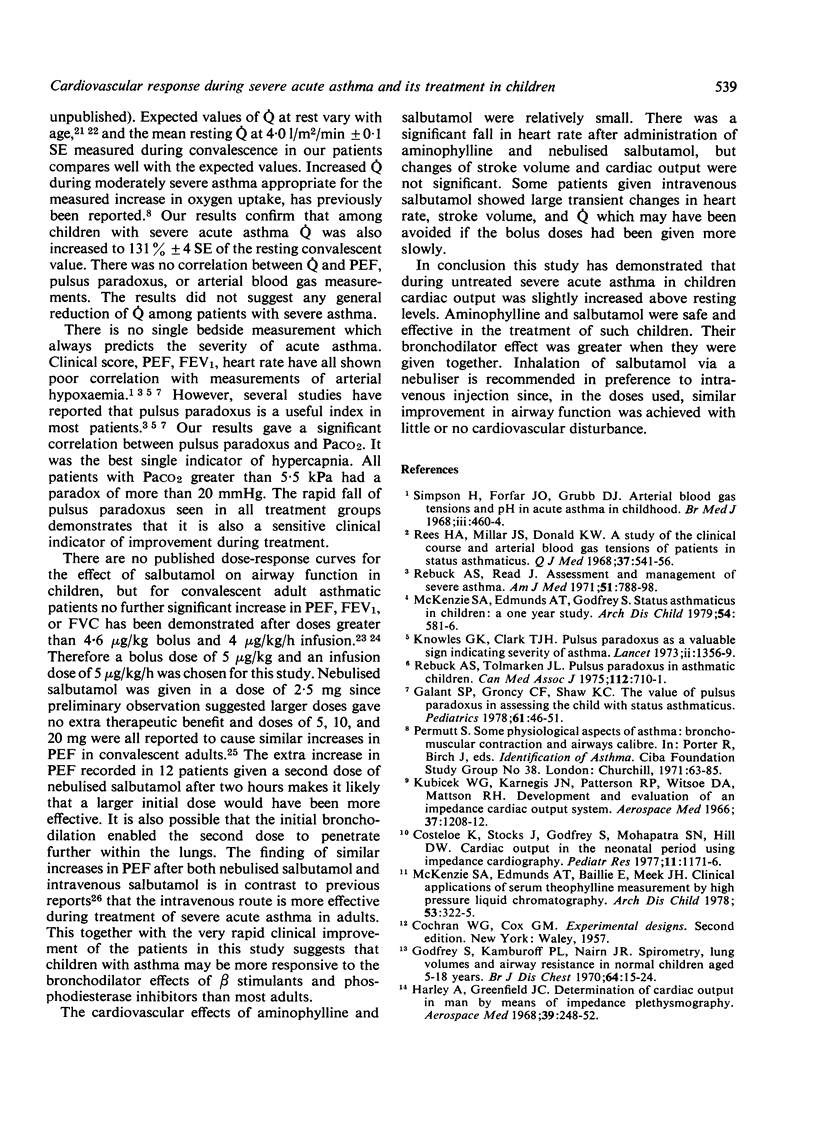
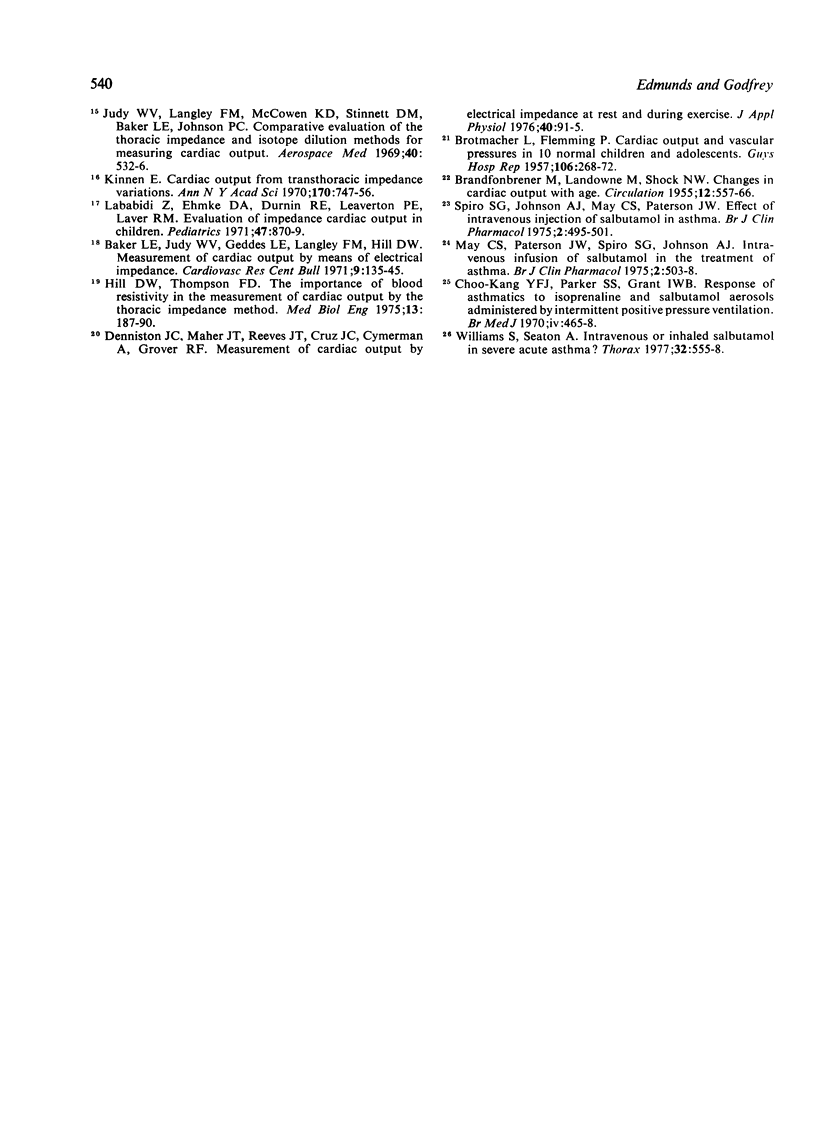
Selected References
These references are in PubMed. This may not be the complete list of references from this article.
- BRANDFONBRENER M., LANDOWNE M., SHOCK N. W. Changes in cardiac output with age. Circulation. 1955 Oct;12(4):557–566. doi: 10.1161/01.cir.12.4.557. [DOI] [PubMed] [Google Scholar]
- BROTMACHER L., FLEMING P. Cardiac output and vascular pressures in 10 normal children and adolescents. Guys Hosp Rep. 1957;106(4):268–272. [PubMed] [Google Scholar]
- Choo-Kang Y. F., Parker S. S., Grant I. W. Response of asthmatics to isoprenaline and salbutamol aerosols administered by intermittent positive-pressure ventilation. Br Med J. 1970 Nov 21;4(5733):465–468. doi: 10.1136/bmj.4.5733.465. [DOI] [PMC free article] [PubMed] [Google Scholar]
- Costeloe K., Stocks J., Godfrey S. Cardiac output in the neonatal period using impedance cardiography. Pediatr Res. 1977 Dec;11(12):1171–1177. doi: 10.1203/00006450-197712000-00001. [DOI] [PubMed] [Google Scholar]
- Denniston J. C., Maher J. T., Reeves J. T., Cruz J. C., Cymerman A., Grover R. F. Measurement of cardiac output by electrical impedance at rest and during exercise. J Appl Physiol. 1976 Jan;40(1):91–95. doi: 10.1152/jappl.1976.40.1.91. [DOI] [PubMed] [Google Scholar]
- Galant S. P., Groncy C. E., Shaw K. C. The value of pulsus paradoxus in assessing the child with status asthmaticus. Pediatrics. 1978 Jan;61(1):46–51. [PubMed] [Google Scholar]
- Godfrey S., Kamburoff P. L., Nairn J. R. Spirometry, lung volumes and airway resistance in normal children aged 5 to 18 years. Br J Dis Chest. 1970 Jan;64(1):15–24. doi: 10.1016/s0007-0971(70)80045-6. [DOI] [PubMed] [Google Scholar]
- Harley A., Greenfield J. C., Jr Determination of cardiac output in man by means of impedance plethysmography. Aerosp Med. 1968 Mar;39(3):248–252. [PubMed] [Google Scholar]
- Hill D. W., Thompson F. D. The importance of blood resistivity in the measurement of cardiac output by the thoracic impedance method. Med Biol Eng. 1975 Mar;13(2):187–191. doi: 10.1007/BF02477726. [DOI] [PubMed] [Google Scholar]
- Judy W. V., Langley F. M., McCowen K. D., Stinnett D. M., Baker L. E., Johnson P. C. Comparative evaluation of the thoracic impedance and isotope dilution methods for measuring cardiac output. Aerosp Med. 1969 May;40(5):532–536. [PubMed] [Google Scholar]
- Knowles G. K., Clark T. J. Pulsus paradoxus as a valuable sign indicating severity of asthma. Lancet. 1973 Dec 15;2(7842):1356–1359. doi: 10.1016/s0140-6736(73)93324-2. [DOI] [PubMed] [Google Scholar]
- Kubicek W. G., Karnegis J. N., Patterson R. P., Witsoe D. A., Mattson R. H. Development and evaluation of an impedance cardiac output system. Aerosp Med. 1966 Dec;37(12):1208–1212. [PubMed] [Google Scholar]
- Lababidi Z., Ehmke D. A., Durnin R. E., Leaverton P. E., Lauer R. M. Evaluation of impedance cardiac output in children. Pediatrics. 1971 May;47(5):870–879. [PubMed] [Google Scholar]
- May C. S., Paterson J. W., Spiro S. G., Johnson A. J. Effect of intravenous injection of salbutamol in asthma. Br J Clin Pharmacol. 1975 Dec;2(6):495–501. doi: 10.1111/j.1365-2125.1975.tb00566.x. [DOI] [PMC free article] [PubMed] [Google Scholar]
- McKenzie S. A., Edmunds A. T., Baillie E., Meek J. H. Clinical applications of serum theophylline measurement by high pressure liquid chromatography. Arch Dis Child. 1978 Apr;53(4):322–325. doi: 10.1136/adc.53.4.322. [DOI] [PMC free article] [PubMed] [Google Scholar]
- McKenzie S. A., Edmunds A. T., Godfrey S. Status asthmaticus in children: a one-year study. Arch Dis Child. 1979 Aug;54(8):581–586. doi: 10.1136/adc.54.8.581. [DOI] [PMC free article] [PubMed] [Google Scholar]
- Permutt S. Some physiological aspects of asthma: bronchomuscular contraction and airways calibre. Ciba Found Study Group. 1971;38:63–85. [PubMed] [Google Scholar]
- Rebuck A. S., Read J. Assessment and management of severe asthma. Am J Med. 1971 Dec;51(6):788–798. doi: 10.1016/0002-9343(71)90307-x. [DOI] [PubMed] [Google Scholar]
- Rebuck A. S., Tomarken J. L. Pulsus paradoxus in asthmatic children. Can Med Assoc J. 1975 Mar 22;112(6):710–711. [PMC free article] [PubMed] [Google Scholar]
- Rees H. A., Millar J. S., Donald K. W. A study of the clinical course and arterial blood gas tensions of patients in status asthmaticus. Q J Med. 1968 Oct;37(148):541–561. [PubMed] [Google Scholar]
- Simpson H., Forfar J. O., Grubb D. J. Arterial blood gas tensions and pH in acute asthma in childhood. Br Med J. 1968 Aug 24;3(5616):460–464. doi: 10.1136/bmj.3.5616.460. [DOI] [PMC free article] [PubMed] [Google Scholar]
- Spiro S. G., Johnson A. J. Intravenous infusion of salbutamol in the treatment of asthma. Br J Clin Pharmacol. 1975 Dec;2(6):503–508. doi: 10.1111/j.1365-2125.1975.tb00567.x. [DOI] [PMC free article] [PubMed] [Google Scholar]
- Williams S., Seaton A. Intravenous or inhaled salbutamol in severe acute asthma? Thorax. 1977 Oct;32(5):555–558. doi: 10.1136/thx.32.5.555. [DOI] [PMC free article] [PubMed] [Google Scholar]


